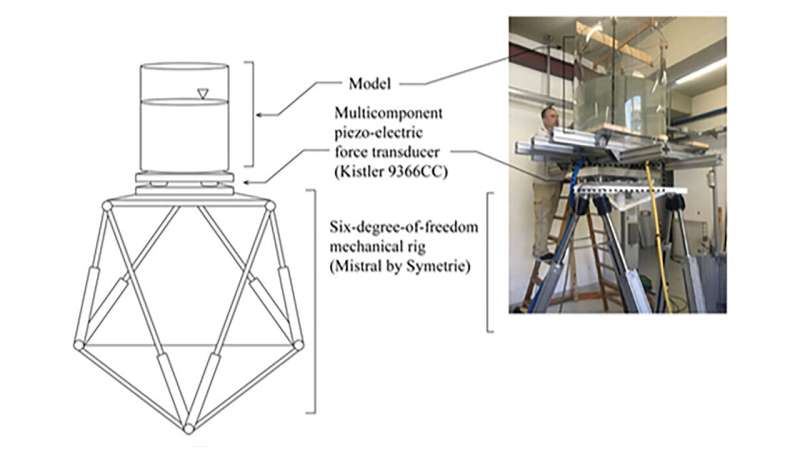Controlling sloshing motions in sea-based fish farming cages improves fish welfare

Sea-based fish farming systems using net pens are hard on the environment and the fish. A closed cage can improve fish welfare, but fresh seawater must be continuously circulated through the cage. However, ocean waves can cause this circulating water to slosh inside the cage, creating violent motions and endangering the cage and the fish.
A study using a scale-model fish containment system is reported in Physics of Fluids. The study shows why violent sloshing motions arise and how to minimize them.
Gentle currents can be artificially maintained inside cylindrical closed cages developed for salmon farming. The current is produced by injecting seawater through nozzles in the side, creating a circular flow inside. The maximum flow rate should not exceed the critical swimming speed at which salmon can swim comfortably for an extended time.
While this artificial current improves fish health, it also affects the natural frequencies of sloshing that can be excited inside the floating cage by ocean waves. These violent sloshing motions occur even when relatively small waves hit the cage, since the resonance phenomenon amplifies wave motion.
"In the scientific literature, similar problems of fluid dynamic behavior in spinning tanks have been found only in studies of stability and control of rocket fuel tanks, gas turbines, and centrifuges," co-author Claudio Lugni said.
"It is not straightforward to apply results about rocket tanks to aquaculture tanks," said co-author Andrei Tsarau.
To address this problem, a scale model of a cylindrical fish cage was attached to a mechanical rig that could move the cylinder from side to side. The scale model was partially filled with water and included nozzles to inject an artificial circular current.
When the system was oscillated sideways by the rig, sloshing motions began and were monitored by sensors in the tank.
"Depending on the forcing frequency, various sloshing regimes characterized by different wave shapes and amplitudes on the free surface of the liquid were observed in the experiment," Lugni said.
Computational and theoretical studies with and without the rotating current were carried out and compared to the experiment. The investigators found the violent sloshing observed when the liquid in the cylinder is not circulated can be suppressed at the same excitation frequencies if the liquid is rotated at high enough angular velocities.
This effect may be beneficial for relatively small cages with a radius less than 10 meters under forced-sloshing conditions. In such cages, the liquid can be rotated at high enough angular velocity without forcing the fish to swim at speeds above their critical limit.
"For larger cages, the same angular velocity would lead to flow velocities too high for the fish," said Tsarau.
More information: "Sloshing in a rotating liquid inside a closed sea cage for fish farming" Physics of Fluids, aip.scitation.org/doi/10.1063/5.0037408
Journal information: Physics of Fluids
Provided by American Institute of Physics





















